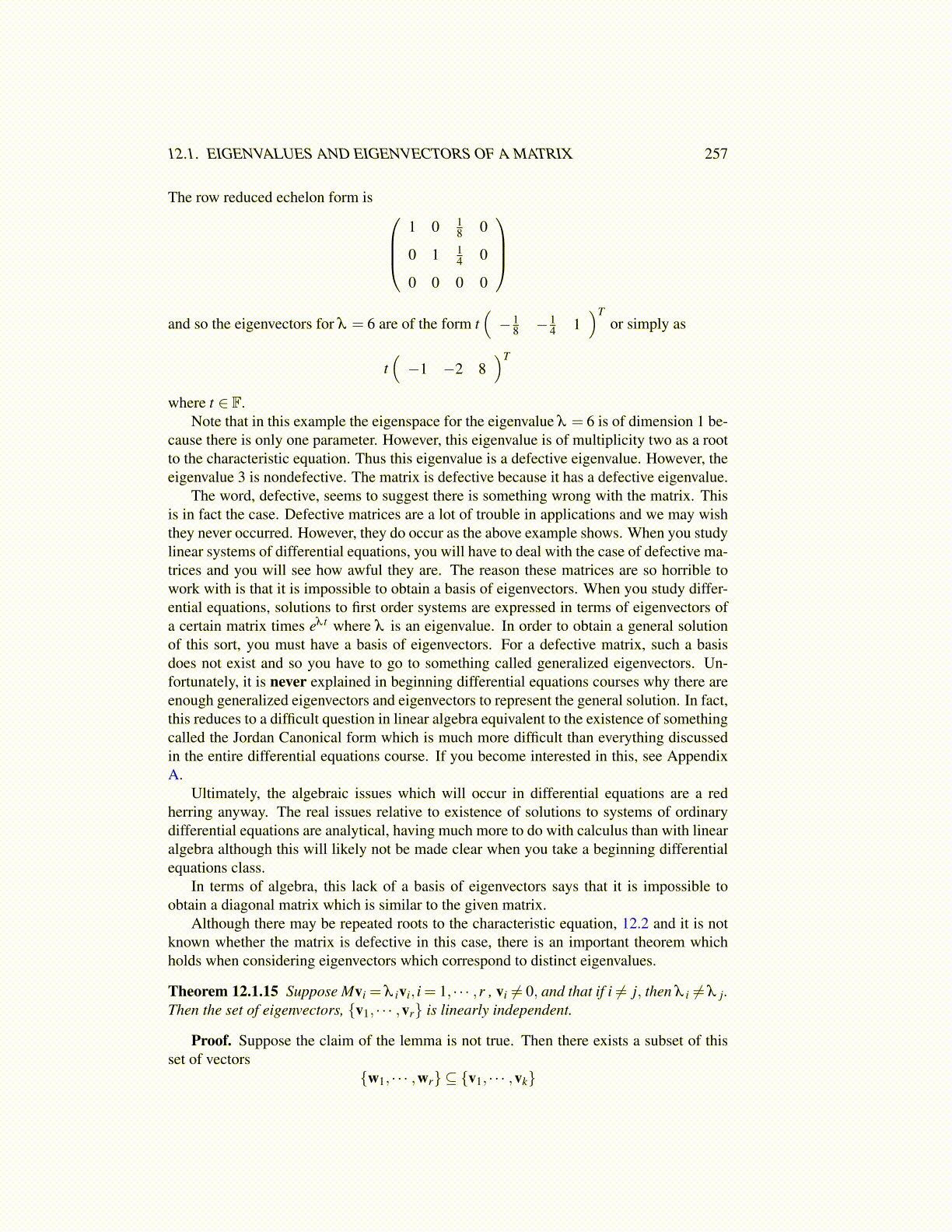
12.1. EIGENVALUES AND EIGENVECTORS OF A MATRIX 257
The row reduced echelon form is 1 0 1
8 0
0 1 14 0
0 0 0 0
and so the eigenvectors for λ = 6 are of the form t
(− 1
8 − 14 1
)Tor simply as
t(−1 −2 8
)T
where t ∈ F.Note that in this example the eigenspace for the eigenvalue λ = 6 is of dimension 1 be-
cause there is only one parameter. However, this eigenvalue is of multiplicity two as a rootto the characteristic equation. Thus this eigenvalue is a defective eigenvalue. However, theeigenvalue 3 is nondefective. The matrix is defective because it has a defective eigenvalue.
The word, defective, seems to suggest there is something wrong with the matrix. Thisis in fact the case. Defective matrices are a lot of trouble in applications and we may wishthey never occurred. However, they do occur as the above example shows. When you studylinear systems of differential equations, you will have to deal with the case of defective ma-trices and you will see how awful they are. The reason these matrices are so horrible towork with is that it is impossible to obtain a basis of eigenvectors. When you study differ-ential equations, solutions to first order systems are expressed in terms of eigenvectors ofa certain matrix times eλ t where λ is an eigenvalue. In order to obtain a general solutionof this sort, you must have a basis of eigenvectors. For a defective matrix, such a basisdoes not exist and so you have to go to something called generalized eigenvectors. Un-fortunately, it is never explained in beginning differential equations courses why there areenough generalized eigenvectors and eigenvectors to represent the general solution. In fact,this reduces to a difficult question in linear algebra equivalent to the existence of somethingcalled the Jordan Canonical form which is much more difficult than everything discussedin the entire differential equations course. If you become interested in this, see AppendixA.
Ultimately, the algebraic issues which will occur in differential equations are a redherring anyway. The real issues relative to existence of solutions to systems of ordinarydifferential equations are analytical, having much more to do with calculus than with linearalgebra although this will likely not be made clear when you take a beginning differentialequations class.
In terms of algebra, this lack of a basis of eigenvectors says that it is impossible toobtain a diagonal matrix which is similar to the given matrix.
Although there may be repeated roots to the characteristic equation, 12.2 and it is notknown whether the matrix is defective in this case, there is an important theorem whichholds when considering eigenvectors which correspond to distinct eigenvalues.
Theorem 12.1.15 Suppose Mvi = λ ivi, i = 1, · · · ,r , vi ̸= 0, and that if i ̸= j, then λ i ̸= λ j.Then the set of eigenvectors, {v1, · · · ,vr} is linearly independent.
Proof. Suppose the claim of the lemma is not true. Then there exists a subset of thisset of vectors
{w1, · · · ,wr} ⊆ {v1, · · · ,vk}